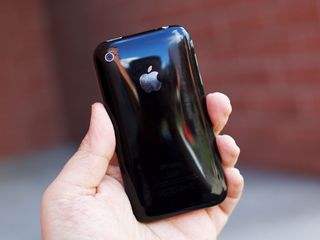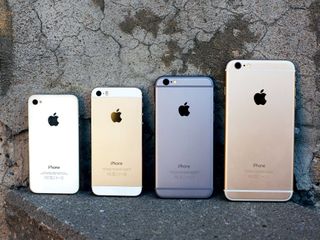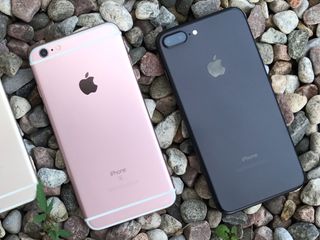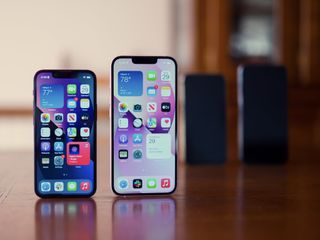A look back at 15 years of iPhone, and what's to come

On January 9, 2007, Steve Jobs walked up on stage at Moscone Center for the Macworld Conference with a keynote address, announcing the first iPhone. That's right — it's been 15 years since the original iPhone launched, and quite frankly, changed the world.
Let's look back on what the original iPhone was like and what's to come for the future of iPhone.
The iPhone was very basic, but unlike anything else at the time

Do you remember what the world of cell phones was like before the iPhone? It was a time when BlackBerry was king, Nokia was still popular (remember the Nokia N95?), and people even still used flip phones like the Motorola RAZR. I personally was using an unlocked Sony Ericsson K800i myself because, at the time, it was considered a "great" camera phone with a whopping 3.2-megapixel camera (LOL).
Jobs said that the iPhone is three things: a widescreen iPod with touch controls, a revolutionary mobile phone, and a breakthrough internet communications device. At the time, most cell phones and even other "smart" phones could access the internet, but it was very basic and only accessible through wireless application protocol (WAP) browsers. The iPhone completely changed this by allowing users to access full web pages as if they were on a desktop computer. And of course, while touch screen devices existed before iPhone, they just weren't that good. Apple got it right with touch screen technology in the original iPhone, as it was the first touch screen iPod, and it changed touch screen phones from that point on.
The shortcomings of the original iPhone

As great as the original iPhone was, let's not forget all the things that it didn't have.
We were stuck with native apps (Phone, Weather, Messages, Notes, etc.) or subpar web apps until the App Store launched in July 2008. And now we have millions of great iPhone apps available for download — if you can think of it, there's probably an app for that. And remember the flood of flashlight apps in the early days of the App Store? That's because there was no LED flash on the first iPhone, which means no flashlight. Those flashlight apps just displayed a white screen at maximum brightness, which was supposed to act as a flashlight. If you look back on these apps now, you'll probably realize how silly that concept was.
Another big thing was copy and paste. Yes, copy and paste was not a thing on the iPhone until 2009, believe it or not. It's something that we simply can't imagine life without now, but there was a time when you could not do something as simple as copy and paste. Oh, and MMS photo messaging was not a thing until iPhone OS 3.0 in 2009, as well, and only for the iPhone 3G and 3GS. Crazy, right?
Master your iPhone in minutes
iMore offers spot-on advice and guidance from our team of experts, with decades of Apple device experience to lean on. Learn more with iMore!
Can you imagine not being able to send photos and videos to your friends and family through the Messages app? Those were dark times…
These days, selfies are ubiquitous everywhere you go, but the original iPhone only had a 2-megapixel rear camera and absolutely no front-facing camera. If you wanted a "selfie," you would need to use the rear camera and hope your image came out right. The iPhone would not get a front-facing camera until the iPhone 4 in 2010. And video recording? That came with the iPhone 3GS in 2009 — the first iPhone was only capable of taking pictures.
You probably rely on your iPhone right now for directions to a new place, right? While the first iPhone had Google Maps preinstalled, it did not have turn-by-turn directions since it lacked GPS. Apple did add GPS to the iPhone 3G to make Maps more accurate, but you'd have to use third-party apps for turn-by-turn directions, due to licensing complications with Google Maps. But native turn-by-turn directions finally arrived in 2012 with iOS 6, and you no longer needed a third-party app for that functionality.

Presently, you can get an iPhone on pretty much any carrier you want. It's hard to think that the iPhone was an AT&T exclusive for four years until the iPhone 4 finally arrived on the Verizon network in June 2010. Soon after, other carriers got the iPhone on their networks as well. For example, T-Mobile began selling the iPhone 5 in 2013. Now, you can pretty much get an iPhone on any carrier, including the smaller MVNOs like Mint Mobile and Visible.
With iOS 14, Apple finally gave us more customization options, but the original iPhone wouldn't even allow you to use a custom Home Screen wallpaper.
Only with iOS 4 did Apple begin to let us choose our own wallpapers to use. Until then, we were stuck with stock wallpapers — seriously, how did we manage?
Today, you're probably using Touch ID or Face ID, in addition to a passcode, to keep your iPhone secure. However, even though the first iPhone had a Home button, it only used a four-digit (six digits wasn't even an option!) passcode for security. Touch ID only became a thing in 2013 since the iPhone 5s, and Face ID arrived with the iPhone X in 2017.
As you can tell, the iPhone 4 was a big step forward for the iPhone, and not just because it brought the first front-facing camera and bumped the rear camera to 5 megapixels. The iPhone 4 also gave us the Retina Display in 2010, which had four times as many pixels as the original iPhone. Afterward, with the iPhone 4s, Apple added Siri, the native, built-in digital voice assistant. I personally don't use Siri as much as I should, but I know some folks who find it useful, especially when your hands aren't available.

The original iPhone also used the old 30-pin dock connector, which was clunky and fairly annoying to use. Apple switched to its new proprietary format, the Lightning connector, with the iPhone 5 in 2012, which is much easier to use as it works both ways. Wireless charging also came with the iPhone 8 series and iPhone X in 2017, making it possible to charge your iPhone without the need for a cable. Finally, the first iPhone did not handle water well, but we now have IP68-rated water resistance on the latest iPhones, making them more friendly for the outdoors.
Clearly, the iPhone was revolutionary at the time and certainly changed the world and affected many lives, including my own. In fact, if it weren't for the original iPhone, I wouldn't be doing what I'm doing for a living today. But it certainly wasn't perfect, and it took time to get to the best iPhone, which is a powerful beast of a pocket computer.
The road ahead for iPhone

This year we are slated to get the iPhone 14 (of course) and iOS 16. With a new iPhone, we can certainly expect things like next-generation processors and longer battery life, but I hope to see even more improvements to the cameras. I mean, we've been at 12 megapixels on the rear camera for the past several years, so I'm hoping to see a bump in megapixel count this year. Or maybe we're finally going to get a full-screen experience with a hole-punch front-facing camera instead of the notch and even under-display Touch ID.
And with iOS 16, I want to see features like auto-rotate, improved interface customization, and scrolling screenshots for other apps besides Safari. After all, we seem to mostly have gotten refinements in iOS 15, so I hope for bigger and better changes in the next iteration of iOS.
Christine Romero-Chan was formerly a Senior Editor for iMore. She has been writing about technology, specifically Apple, for over a decade at a variety of websites. She is currently part of the Digital Trends team, and has been using Apple’s smartphone since the original iPhone back in 2007. While her main speciality is the iPhone, she also covers Apple Watch, iPad, and Mac when needed.
When she isn’t writing about Apple, Christine can often be found at Disneyland in Anaheim, California, as she is a passholder and obsessed with all things Disney, especially Star Wars. Christine also enjoys coffee, food, photography, mechanical keyboards, and spending as much time with her new daughter as possible.
Most Popular




